Two for Toons
Animators Norton Virgien ’74 and Charles Grosvenor ’74 draw on Bates friendship
Interview and photos by Phyllis Graber Jensen
Norton Virgien ’74 toils in an outrageously revamped Mercedes-Benz dealership in the gritty vicinity of Hollywood’s Sunset Boulevard. Boyish and charming, Virgien sports a roguish grin, jeans, and running shoes a suitably hip look for a guy whose work on the Rugrats animated series offers a witty, kid’s-eye view of the world.
Five miles away in spiffy Universal City, friend and classmate Charles Grosvenor presents a more staid persona graying head, black chinos, and penny loafers. Grosvenor oversees Universal Studios’ beloved Land Before Time animated series, chronicling the adventures and life lessons of ebullient young dinosaurs.
Grosvenor’s office, on the 25th floor overlooking the company’s theme park and movie lot, has a corporate sense of restraint.
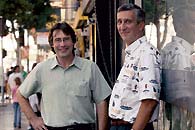
Virgien tools around the Hollywood Hills in his red Chrysler Sebring convertible. Grosvenor commutes to and from his Pasadena home in a Saturn sedan.
“They were quite different from the outset,” notes their Bates art mentor, Donald Lent, professor emeritus of art. “But both were serious students with goals.”
What also unites them is the ability to tell a darn good story in cartoons. “Animation history is littered with poorly made feature films by terrific draftsmen who had no clue as to how to create an overall story,” Virgien (Ver-JEEN) tells a visitor.
“At Universal,” Grosvenor (GROVE-ner) says, “we look for what anyone looks for in a story: a strong, positive plot line with good, appealing characters who show a convincing character arc over the course of the picture.”
Indeed: Land Before Time is now one of the longest-running, best-selling direct-to-video animated franchises. Sales have topped 60 million units, and the most recent installment, The Great Longneck Migration, celebrates the series’ 15th anniversary.
As a member of the famously innovative Klasky Csupo animation studio (The Simpsons, Rugrats, Duckman, Wild Thornberrys, among others), Virgien’s directorial credits include dozens of Rugrats television episodes, The Rugrats Movie (1998), and, most recently, Rugrats Go Wild (2003).
Rugrats offers the kind of not-just-for-kids laughs we all remember from, say, Chuck Jones’ Bugs Bunny toons half a century ago. “[Rugrats] supplies a time in the day when you and the kids can get together in front of the set and laugh, often for different reasons,” notes critic Roger Ebert.
Virgien, says Lent, “was easygoing, as if he wasn’t doing anything. But in fact he was doing more work than almost any other student I had. I have this image of Nort in sneakers and corduroys, listening to music and drawing really trying to learn comic-book drawing.”
Meanwhile, Grosvenor’s space at Bates, at the Russell Street “farm” in those pre-Olin days, was pin neat.
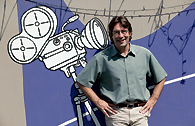
“He could pull out a note from a pile of papers with perfect assuredness,” Lent remembers.
Now, Lent says, “both are really great men, extremely independent, who both went out on their own cold.” Like many post-college friendships, Virgien and Grosvenor’s is not sustained by daily contact. Put the two together, say for lunch at the Hollywood Boulevard Hamburger Hamlet, and the longstanding rapport kicks right in.
Norton, you’ve got teenagers. Charlie, an 8-year-old. How has fatherhood affected your movies?
Virgien: It was terrific that my kids were 5 and 7 when I started working on Rugrats. Many of the key people involved in our first season had young children so we could remember what it was like to be the bumbling parent. There’s no doubt that part of the show’s charm in the first two seasons was its truthful depiction of the parenting experience. It was almost home movies.
When my son was 7, he and I were talking about what would happen if the Rugrats were drawn in children’s art style and came to life. We created a very sweet little episode [the Emmy-winning “Home Movies,” 1993] where each of the main Rugrats did a sketch in their own style, coming to life and revealing the personalities of the characters through their fantasies. We brought a dozen of our kids, mine included, into the studio one Saturday afternoon. They literally designed the storyboards, and the scenes were taken virtually verbatim from their drawings.
Grosvenor: My boy enjoys Land Before Time to a point, because he’s right around the age where kids will leave for more adventurous shows. My son can be a good barometer for how other kids will react. As much as we try to see things through the eyes of a kid, there’s nothing that compares to having their reaction to a story. After one show was completed last year, I asked him what he thought. “It’s my favorite, and it’s the one I hate the most too,” he said. “I just loved the new character, but at the end I hated that the new character didn’t stay with the others.” Because of his response, in the next show, I drew in a couple of cameos of that character coming back so that other people can see that he’s still alive out there and returns periodically.
Virgien: As the kids grow up we see ourselves creating shows for older audiences. We all have our own little personal audiences in mind sometimes. You create more effectively when you’re thinking about your audience. That’s the difference between being in a fine art where the artists are often creating out of their soul, and creating in a commercial sense where you’re creating for a particular audience.
Do you consider your influence on your audience?
Virgien: It’s huge for me. I remember giving pep talks to the crew, saying, “You know there are going to be a lot of kids and this is going to be the first movie that they ever see.” We make a movie that will make these kids laugh and cry, that will be with them their whole lives. It inspired us to make the movie more emotionally rich.
Grosvenor: We have a very narrow window of audience age-wise, so we have to constantly be aware of what is too much for them to deal with. If we have an attack by a T-Rex or a predator, or even a guest dinosaur, how nasty can we make that? We always have to keep in mind what is tolerable for the kids to watch.
Virgien: The hardest screening I ever sat through was an early cut of The Rugrats Movie, which was a little too scary. I sat in a row right behind a couple of parents who were crewmembers and had brought their 4-year-olds along. These kids started crying at a certain point in the movie because they were scared, and I felt personally responsible for it. As a result, we pulled back on our sound effects and scary music. We also know that kids are going to these movies a hundred times. That was never the case when we were kids. You’d see Snow White once and then it would come back seven years later. We work harder now to put a lot of extra detail into films, little jokes that they might not pick up until the fifth time they watch it. We try to make the films at least intelligent enough so adults can tolerate watching them, and watching them more than once. When kids are this little it’s important for parents to watch with the kids.
Grosvenor: What we’ve been able to do is parallel to what Nort has been able to do with Rugrats. You have characters that are extremely recognizable: The audience wants to see what’s happening next and where they’ll go. There’s one 8-year old in Colorado who writes me frequently. He always wants to know about new characters or story ideas, and that kind of interaction is always very appealing.
What qualities do you think allowed you each to succeed in the business?
Virgien: At Bates I got a real sense of possibilities Bates was a place where you could try most anything you wanted to try,
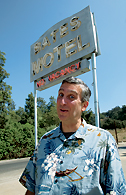
and there were professors who would offer incredible support and mentoring. So when I got out into the world I sort of dove into the bigger ponds with enough self-confidence to at least try a lot of things.
The education and discipline learned at Bates allowed us to use other talents and consequently rise. Someone else might be a great painter or a great draftsman, but not have organizational skills or research skills or ability with a story. Many of the people who try to become directors of animation have done 15 years of brilliant animation a one-frame-at-a-time craft. The best animators at Disney, for instance, might ultimately create three or four minutes of one of their films. They’re so focused on frame-by-frame work that they don’t necessarily have the opportunity to think of the film as a whole.
Professor Emeritus of Art Don Lent influenced you both at Bates. How?
Grosvenor: I cannot stress enough the impact Professor Lent had on my Bates years and subsequent career. For me he was the ideal professor. I did not want a drinking buddy or “pal” as my mentor. I wanted someone who could teach, elevate, and advise. And all of these things Professor Lent did for me.
Virgien: The art major was brand new, and we were a small, talented group with a professor who was really
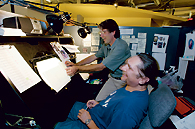
interested in each of us and in helping us find what we might be good at. One Short Term, Don organized a really cool project of painting an outdoor mural in Lewiston. He was looking for roles for everybody, and he saw that I had an interest in filmmaking. He said, “How would you like to document this process with your Super 8 movie camera?” I made a little film, the first time that I had ever put together a movie with that kind of subject that people responded to.
Now, as I develop new story ideas, the thought processes that went into telling that story 30 years ago are still the ones I use today. When I am directing looking at a group of artists assembled to make a movie, figuring out which ones would be good at which assignments and which artists could bring that certain Rugrat to life that’s exactly what Don Lent was doing back then in finding film in me.
In 1999, The Rugrats Movie, with Nort as co-director, was the first non-Disney animated feature to gross more than $100 million at the U.S. box office. What’s the trend in animation since then?
Virgien: The concept of TV shows becoming animated features was exploited. When we did The Rugrats Movie for Paramount we were the first to do that in a while. We worked really hard to make it different from the TV show so that when people paid money to go see it as a big feature it was worth it to them. Subsequently some films were done that were basically not much more than the television show projected large, and I think people felt a little bit disappointed. That affected the whole genre.
Grosvenor: Animation has been in rather difficult straits for the past three years. It is a relatively volatile industry and you go from project to project, or year to year, and hope that it keeps going. Except for the films that Norton has done, it has been really tough.
Virgien: Our last films, The Wild Thornberrys and Rugrats Gone Wild, performed adequately, but not as well as our earlier ones, so that trend is passing. Film is trend-oriented. We were developing an exciting adventure mythology story that everyone at the studios we work with loved. Then there were a couple failures of animated adventure stories. So, now everyone is telling us, “Why don’t you make something as funny as Finding Nemo?” We’re always subject to the winds that blow.
A 72-minute picture like The Land Before Time can represent more than 100,000 individual images, and most animation is now drawn mostly overseas in Asia. What are the effects of this trend?
Virgien: Charlie and I started at exactly the time the studios discovered they could go to Taiwan and get the animation done for less than half the cost. When we started working cartoons were done in a very simplified way to keep the number of man-hours down because American labor costs are high. Think of the old cartoons, like Scooby-Doo, where the characters just bob their heads. We were all afraid we would lose our jobs when work went overseas. But when the studio started using overseas talent to create the actual animation, we found we had much more freedom to let the characters move and to develop more of them.
Grosvenor: Computer animation can create almost any kind of character effectively.
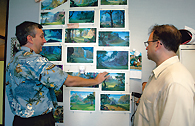
There are still limitations in what computers can do in creating human characters, but that’s just the next frontier. Switching to computer animation is not unlike switching from drawing to painting — it’s another craft to master, but the basic skills you use are similar. The success of Pixar ultimately comes down to the fact that Toy Story or Nemo are entertaining stories, first, that happen to be done with computers.
Virgien: We’re realizing that despite all the genuine charms of hand-drawn animation, audiences are finding the richness of the computer animation look to be more compelling. The whole industry is basically rethinking itself. Luckily for Charlie and me, the technique that’s used for animation is transferable, and we’ll be directing computer animation.
The other thing that has been great is that Hollywood is now the world center of animation. All these brilliant artists from throughout Eastern Europe, Asia, England, and France are passing through Klasky Csupo. Even as the business changes from hand-drawn to computer animation, with much of the animation done in Korea and Taiwan, if you keep that youthful enthusiasm, you’ll come through, still learning and growing.
So, how different are you from each other?
Grosvenor: I remember we used to joke about one of Norton’s least-favorite Bates sayings: “Slow and steady wins the race.”
Virgien: I was always impatient. We were very good friends in college, but very different people. We lived on the same floor, and on a Friday night I’d come staggering into the room. Charlie would be working on something, and I’d say, “Charlie, it’s Friday night!” Charlie has always been a focused guy.
How did the two of you end up in Los Angeles?
Virgien: My girlfriend [now wife] Joanie Mitchell ’73 and I just drove out here with our stuff and got a motel room on Sunset Boulevard. I still remember my naiveté, dressing up in a suit, going to Universal Studios and Disney to fill out applications to be a film director or any other job they might have had. I don’t know if those applications have any place to stop before the wastebasket, but I do know how much I spent on that suit! I got lucky and heard about a job in animation. Because I had my trusty art major’s portfolio, that’s what happened.
Grosvenor: Norton came East during Christmas ’77 and told me it was a good time to come on out. That was a kick in the pants that got me out of New Jersey, where I was trying to do cartooning for newspapers. Norton’s initiative and courage made it easier for me because when I came out here, he and Joan were very kind to me. They had me stay with them until I got my feet on the ground.
Virgien: Charlie’s taken a disciplined path, working step by step to get where he’s gotten. When he was putting in the time at Hanna-Barbera, I was jumping from small companies to having my own company, to working in Japan, to quitting animation and going to Vermont to be a writer, and then to New York to learn to be a director, and then back to LA. So I made up for what I didn’t have in discipline with a lot of energy and enthusiasm and a willingness to cast my fate to the wind.
Grosvenor: It’s funny that we ended up in very similar sorts of situations. I didn’t have the courage that Norton had to do what he did, to start his own company, to go to Japan to work on projects. I tip my hat to him for that.
Will the two of you ever work together on a project?
Virgien: When Charlie first came out here, we worked for two different companies, but right across the street from each other, so we would probably have lunch once every week or two and talk about all the many amazing things that we were going to do. A portion of those things lead you somewhere. You have to have those dreams. We also learned over the years that great ideas and commercial ideas aren’t always the same thing!
Grosvenor: Someday it may still happen.
Virgien: Someday, some way, it will happen.